NCERT Solutions Class 8 Science
The NCERT Solutions in English Language for Class 8 Science Chapter – 16 (Light) has been provided here to help the students in solving the questions from this exercise.
Chapter – 16 (Light)
1. Suppose you are in a dark room. Can you see objects in the room? Can you see objects outside the room? Explain.
Answer – No, we cannot see the objects in a dark room because we need a source of light to make the objects visible. We can see an object only when it reflects the light falling on it towards our eyes. If the light is available outside the room, then the objects present would reflect it and hence we would be able to see objects.
2. Differentiate between regular and diffused reflection. Does diffused reflection mean the failure of the laws of reflection?
Answer – The difference between Regular and diffused reflection is
| Regular Reflection | Diffused Reflection |
| Rays of light falls on smooth surface | Rays of light falls on irregular surface. |
| Rays are reflected parallely. | Rays are reflected in different directions. |
| Reflection is clear. | Reflection is not clear. |
| Example – Reflection by the plane mirror. |
Example – Reflection by the road surface. |
No, diffused reflection does not mean failure of law of reflection. It is caused by the irregularities of the reflecting surface The laws of reflection are valid at each point on the surface of an object.
3. Mention against each of the following whether regular or diffused reflection will take place when a beam of light strikes. Justify your answer in each case.
(a) Polished wooden table
(b) Chalk powder
(c) Cardboard surface
(d) Marble floor with water spread over it
(e) Mirror
(f) Piece of paper
Answer –
| Question | Reflection Type | Explanation |
| Polished wooden table | Regular Reflection | A polished wooden table has a smooth surface, so the reflection on a polished table will be regular reflection |
| Chalk powder | Diffused Reflection | Chalk powder if spread on a surface makes the surface diffused, so the reflection on a chalk powder is diffused reflection |
| Cardboard surface | Diffused Reflection | Cardboard surface is not smooth, so the reflection will be a diffused reflection |
| Marble floor with water spread over it | Regular Reflection | Marble floor with water spread over it is a smooth reflection. Water makes the marble smooth, so the reflection on the marble floor will be a regular reflection |
| Mirror | Regular Reflection | Mirror has a smooth surface, so the reflection on the mirror is a smooth reflection |
| Piece of paper | Diffused Reflection | Since the surface of a piece of paper will be rough, it would produce a diffused reflection |
4. State the laws of reflection.
Answer – The laws of reflection are –
- The incident ray, the reflected ray and the normal (at the point of incidence) , all lie in the same plane.
- The angle of incidence is equal to the angle of reflection.
5. Describe an activity to show that the incident ray, the reflected ray and the normal at the point of incidence lie in the same plane.
Answer –
Activity – To show that the incident ray, reflected ray and the normal at the point of incidence lie in the same plane.
Materials Required: Plane mirror, holder, ray box, etc.
Procedure – Fix sheet of white paper, a little beyond the edge of the board. Place a plane mirror strip vertically to the paper using a stand. Throw light from a ray box on the mirror. Look at the reflected ray. Mark the incident ray, normal ray and reflected ray. Fold the paper which is beyond the edge of the board. You will observe that the reflected ray is not seen in the folded portion of the chart paper. Now bring the folded portion back to its original position. The reflected ray of light is again seen on the page.
Conclusion – The sheet on the board can be considered as a plane. The incident ray, the reflected ray, the normal at the point of incidence lie in the same plane.

Incident ray, reflected ray and normal at the point of incidence lie in the same plane
6. Fill in the blanks in the following.
(a) A person 1 m in front of a plane mirror seems to be _______________ m away from his image.
(b) If you touch your ____________ ear with your right hand in front of a plane mirror, it will be seen in the mirror that your right ear is touched with your ____________.
(c) The size of the pupil becomes ____________ when you see in dim light.
(d) Night birds have ____________ cones than rods in their eyes.
Answer –
(a) A person 1 m in front of a plane mirror seems to be 2 m away from his image.
(b) If you touch your left ear with your right hand in front of a plane mirror, it will be seen in the mirror that your right ear is touched with your left hand.
(c) The size of the pupil becomes large when you see in dim light.
(d) Night birds have fewer cones than rods in their eyes.
Choose the correct option in Questions 7 – 8
7. The angle of incidence is ________ equal to the angle of reflection.
(a) Always
(b) Sometimes
(c) Under special conditions
(d) Never
Answer – (a) Always
8. Image formed by a plane mirror is
(a) virtual, behind the mirror and enlarged.
(b) virtual, behind the mirror and of the same size as the object.
(c) real at the surface of the mirror and enlarged.
(d) real, behind the mirror and of the same size as the object.
Answer – (b) virtual, behind the mirror and of the same size as the object.
9. Describe the construction of a kaleidoscope.
Answer – Kaleidoscope is a device based on the principle of multiple reflections. It consists of three long and narrow strips of plane mirrors inclined at an angle of 60° to one another forming prism. This is fitted in a tube. One end of this tube is closed by a cardboard disc having a hole at its center. To the other end touching the mirrors plane glass plate is fixed on which broken pieces of colored bangles are placed. This end of the tube is closed by a ground glass plate.
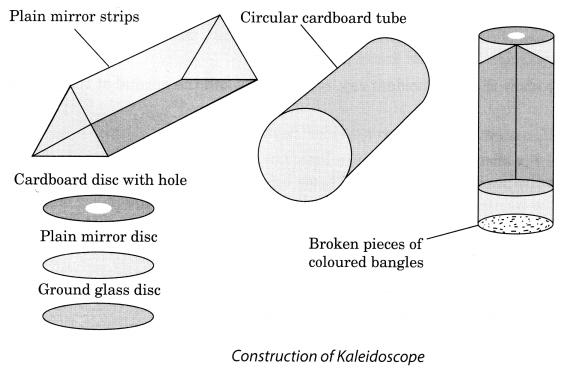
10. Draw a labelled sketch of the human eye.
Answer –
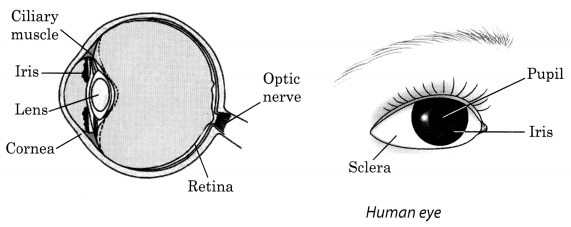
11. Gurmit wanted to perform Activity 16.8 using a laser torch. Her teacher advised her not to do so. Can you explain the basis of the teacher’s advice?
Answer – Teacher has advised Gurmit not to do so because laser light is very harmful for her eyes and can cause a permanent defect in the eye. Person can even lose his or her eyesight if laser torch is directed over the eyes.
12. Explain how you can take care of your eyes.
Answer – Eyes are very precious. We must take proper care of them. We must
- always sit straight while reading or writing.
- if advised, use suitable spectacles.
- wash our eyes with clean water frequently.
- not look at the sun directly.
- always read or write in a proper light.
13. What is the angle of incidence of a ray if the reflected ray is at an angle of 90° to the incident ray?
Answer – Here, the angle of reflection is 90°. As we know, according to the laws of reflection that angle of incidence is equal to angle of reflection.
Here, the angle between the incident ray and reflected ray is 90°.
i.e.,
∠i + ∠r = 90°
Since, ∠i = ∠r
We can write, ∠i + ∠i = 90°
⇒ 2∠i = 90°
⇒ ∠i = 45°
Angle of incidence = 45°.
14. How many images of a candle will be formed if it is placed between two parallel plane mirrors separated by 40 cm?
Answer – Here, mirrors are placed parallel to each other 40 cm apart. Therefore, the infinite number of images will be formed.
15. Two mirrors meet at right angles. A ray of light is incident on one at an angle of 30° as shown in Fig. 16.19. Draw the reflected ray from the second mirror.
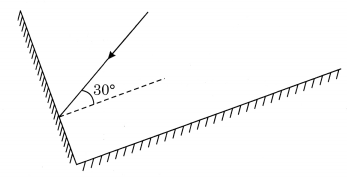
Answer – The first law of reflection is used to obtain the path of reflected light.
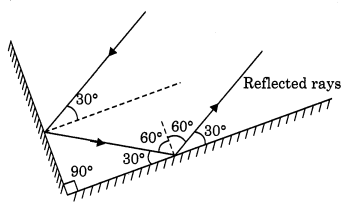
It can be observed that the given ray of light will reflect from the second mirror at an angle of 60°.
16. Boojho stands at A just on the side of a plane mirror, as shown in Fig. 16.20. Can he see himself in the mirror? Also, can he see the image of objects situated at P, Q and R?
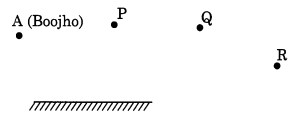
Answer – No, Boojho can’t see himself in the mirror. He can see the image of the object at P and Q but not of R.
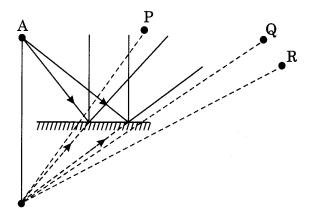
17.
(a) Find out the position of the image of an object situated at A in the plane mirror (Fig. 16.21).
(b) Can Paheli at B see this image?
(c) Can Boojho at C see this image?
(d) When Paheli moves from B to C, where does the image of A move?
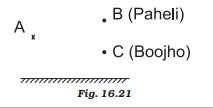
Answer –
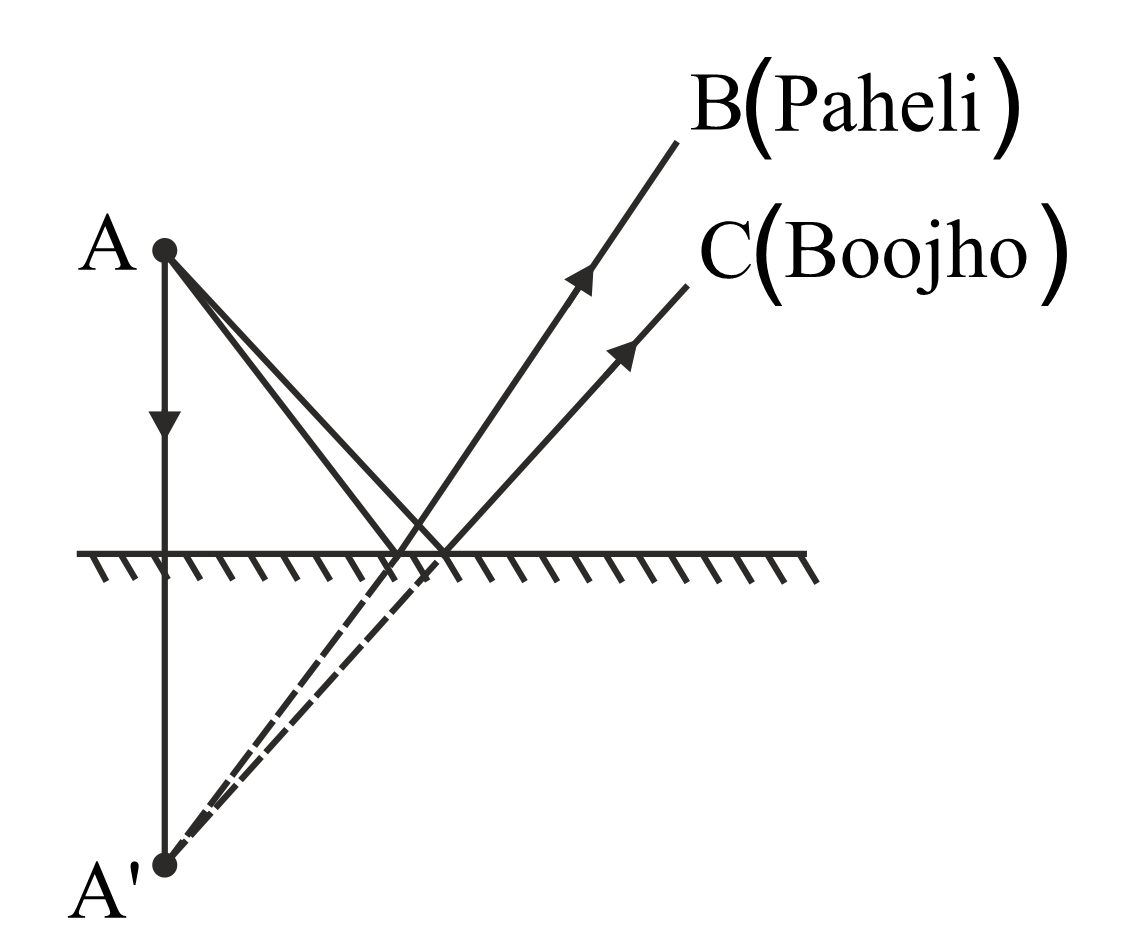
(a) Image of the object placed at A is formed behind the mirror. The distance of the image from the mirror is equal to the distance of A from the mirror.
(b) Yes, Paheli at B can see this image.
(c) Yes, Boojho at C can see this image.
(d) Image of the object at A will not move. It will remain in the same position when Paheli moves from B to C.

